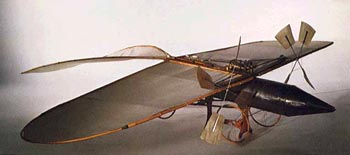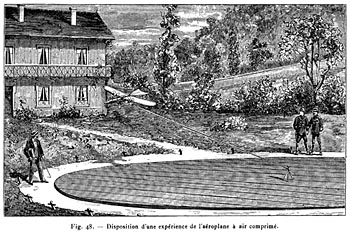Victor
Tatin
(1843-1913)

Victor Tatin
Frenchman, Victor Tatin
became one of early aviation's most authoritative theorists.
He built a model in 1879
with a fuselage that acted as a tank for the compressed air
that drove a small engine linked to two tractor propellers.
The model had a 75ins
(1.9m) wingspan. It was attached to a pole, and flew in
circles around the pole for some 49ft (15m).

Victor Tatin compressed air powered Aeroplane of 1879
He first began with
beating wings, and produced, in 1876; an artificial bird

Victor Tatin Ornithopter of 1874
This was driven by twisted
rubber; not only did M. Tatin find that the power required
was unduly great, but he also found that this power could
not be accurately measured, the torsion of indict-rubber
being erratic and stretching unequally.

Victor Tatin Ornithopter of 1875
He
constructed a large number of mechanical birds of all sizes
and various weights; he tried many modifications and entire
or partial reconstructions, and finally concluded, after
spending a good deal of time and money, to take up the
aeroplane type, to be driven by a reservoir of compressed
air. With this his efforts were successful almost from the
first, and he produced in 1879 the apparatus which was
practically the first that had risen into the air by a
preliminary run over the ground.

Victor Tatin compressed air powered Aeroplane of 1879
This machine consisted in
a silk aeroplane, measuring 7.53 sq. ft. in surface, being
6.23 ft. across and 1.31 ft. wide, mounted in two halves at
a very slight dihedral angle, on top of a steel tube with
conical ends which contained the compressed air. This
reservoir was 4 3/4 in. in diameter and 33 1/2 in. long, was
tested to a pressure of 20 atmospheres, and worked generally
at 7 atmospheres; its weight was only 1.54 lbs., and its
cubical capacity 0.28 cub. ft.

Victor Tatin compressed air powered Aeroplane of 1879
|
